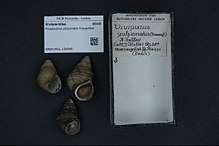Angulyagra polyzonata
Angulyagra polyzonata is a species of a freshwater snail with a gill and an operculum, an aquatic gastropod mollusk in the family Viviparidae.
| Angulyagra polyzonata | |
|---|---|
 | |
| Angulyagra polyzonata shells | |
| Scientific classification | |
| Kingdom: | |
| Phylum: | |
| Class: | |
| (unranked): | |
| Superfamily: | |
| Family: | |
| Subfamily: | Bellamyinae |
| Genus: | Angulyagra |
| Species: | A. polyzonata |
| Binomial name | |
| Angulyagra polyzonata (Frauenfeld, 1862) | |
| Synonyms[1] | |
|
Sinotaia polyzonata Frauenfeld, 1862 | |
Distribution
This species is found in southern and southeastern China[1] and in northern Vietnam.[1][2] It is non-indigenous in Taiwan.[3]
Description
The width of the shell is 11.2–21.4 mm.[4] The height of the shell is 13.8–32.5 mm.[4]
Similar species is Bellamya heudei.[5]
Ecology
Habitat
Angulyagra polyzonata lakes, rivers, creeks and drains.[1] It is a common species in aquaculture ponds.[4]
Parasites and predators
Angulyagra polyzonata is a host of a trematode Multicotyle purvisi.[6]
Predators of Angulyagra polyzonata include the black carp Mylopharyngodon piceus.[4]
Human use
This species is eaten by people and it is used as fish, poultry and livestock raising.[1] It is usually collected from the aquaculture pond when the pond is empty.[4]
References
- Sri-aroon, P. & Richter, K. (2012). Angulyagra polyzonata. The IUCN Red List of Threatened Species 2012: e.T166246A1121937. https://dx.doi.org/10.2305/IUCN.UK.2012-1.RLTS.T166246A1121937.en. Downloaded on 20 November 2017.
- Madsen H. & Hung N. M. (2015). "Reprint of “An overview of freshwater snails in Asia with main focus on Vietnam”". Acta Tropica 141(Part B): 372–384. doi:10.1016/j.actatropica.2014.10.014.
- (in Chinese) 蔡政達(Cheng-Da Tasi), 蘇俊育(Chun-Yu Su) & 邱郁文(Yuh-Wen Chiu) (2009). "臺灣新紀錄外來種:多稜角螺Angulyagra polyzonata (Frauenfeld, 1862)(腹足綱:田螺科)之形態描述與生殖生物學初探. A Morphological Description and Reproductive Biology of Angulyagra polyzonata (Frauenfeld, 1862) (Gastropoda: Viviparidae) as a Snail Newly Recorded Specice to Taiwan". Bulletin of Malacology 33(1): 1-14. abstract.
- Hung, N. M., Stauffer, J. R., & Madsen, H. (2013). Prey species and size choice of the molluscivorous fish, black carp (Mylopharyngodon piceus). Journal of freshwater ecology, 28(4), 547-560. doi:10.1080/02705060.2013.800826.
- Shea, M. (1994). The Chinese viviparid snail Bellamya heudei guangdungensis (Kobelt, 1906) in Australia (Prosobranchia: Viviparidae). Molluscan Research, 15(1), 3-11. doi:10.1080/13235818.1994.10673652.
- Alevs, Philippe V.; Vieira, Fabiano M.; Santos, Cláudia P.; Scholz, Tomáš; Luque, José L. (2015-02-12). "A Checklist of the Aspidogastrea (Platyhelminthes: Trematoda) of the World". Zootaxa. 3918 (3): 339–96. doi:10.11646/zootaxa.3918.3.2. ISSN 1175-5334. PMID 25781098. S2CID 11731430.
